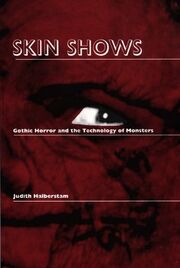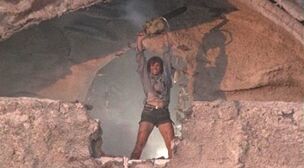Tag: Visual edit |
(Undo revision 6695 by 2610:130:112:101:C5A5:1CE2:F3A6:CE7F (talk)) |
||
| Line 12: | Line 12: | ||
==='''Chapter 2 - Making Monsters: Mary Shelley's ''Frankenstein '''''=== |
==='''Chapter 2 - Making Monsters: Mary Shelley's ''Frankenstein '''''=== |
||
| − | Halberstam reads ''Frankenstein ''(1831) as an "allegory" of Gothic novel production, one that |
+ | Halberstam reads ''Frankenstein ''(1831) as an "allegory" of Gothic novel production, one that creates "stories and narrative perspectives like a machine" (23). He introduces the idea of Gothic text and monster as part of the Gothic machine, or "technology of monstrosity", which is antithetical to humanity and also the mechanism for producing what he terms the "totalizing monster." Halberstam uses Victor Frankenstein's monster as an example of the totalizing monster, one which is produced by the amagamation of parts from all races, classes, genders, and sexualities. |
Revision as of 14:23, 2 February 2018

Front cover of paperback edition
Skin Shows is the first book-length work of literary criticism written by Dr. Judith "Jack" Halberstam . Published in 1995, it reads canonical Gothic literature of the 19th century (i.e. Frankenstein, The Strange Case of Dr. Jekyll and Mr. Hyde, The Portrait of Dorian Grey, and Dracula) alongside canoncial Gothic films of the 20th century (i.e. The Birds, The Texas Chain Saw Massacre, The Texas Chainsaw Massacre 2, and The Silence of the Lambs). By tracing the transition from literary to filmic Gothic, he points out that the two affect fear by different means. Mobilizing the idea of skin as its guiding metaphor, the book argues that filmic Gothic may be defined by visual representations of skin that affect shock, while literary Gothic may be defined by linguistic representations of psychopathology that affect paranoia. The book also mobilizes the idea of the machine as a metaphor for the Gothic monster, and the monster as a metaphor for the text itself. The Gothic is thus what the subtitle calls a "Technology of Monstrosity", a machine that manufactures the monster as a cultural text and reproduces monsters in the form of both literature and film.
Chapter Summary
Chapter 1 - Parasites and Perverts: An Introduction to Gothic Monstrosity
Halberstam opens by describing the serial killer, Buffalo Bill from The Silence of The Lambs, covered in the skin of his female victims and dancing in front of a full-length mirror. The image illustrates how far the Gothic has come since its popularization in the 19th century in terms of visualizing graphic sexuality as monstrously obscene. Halberstam argues that this instance is indicative of a late-20th century Gothic that is more concerned with showing us explicit, shocking images of skin and body.
Chapter 2 - Making Monsters: Mary Shelley's Frankenstein
Halberstam reads Frankenstein (1831) as an "allegory" of Gothic novel production, one that creates "stories and narrative perspectives like a machine" (23). He introduces the idea of Gothic text and monster as part of the Gothic machine, or "technology of monstrosity", which is antithetical to humanity and also the mechanism for producing what he terms the "totalizing monster." Halberstam uses Victor Frankenstein's monster as an example of the totalizing monster, one which is produced by the amagamation of parts from all races, classes, genders, and sexualities.
Chapter 3 - Gothic Surface, Gothic Depth: The Subject of Secrecy in Stevenson and Wilde
Halberstam uses queer theory to juxtapose The Strange Case of Dr. Jekyll and Mr. Hyde (1886) with The Portrait of Dorian Grey (1891). In representations of surface and depth, he argues, they are inversions of one another. That is, the narrative of Jekyll and Hyde progresses from a concern with the well-mannered appearance of Dr. Jekyll to an obsession with the depth of depravity in Mr. Hyde, while the narrative of Dorian Grey progresses from a concern with the aesthetic depth of Dorian to an obession with the warped appearance of his portrait's surface. These narratives thus allegorize the shift from 19th to 20th century Gothic, as literature transitions to film, and representation of deep, psychological terror become representations of skin-level horor.
Chapter 4 - Technologies of Monstrosity: Bram Stoker's Dracula
Halberstam reads Bram Stoker's Dracula (1897) as "a cornerstone of Gothic writing," because it represents another totalizing monster in the form of the Count Dracula, whom he calls "a brother to Frankenstein's monster" (24). He also draws a litany of comparisons between the wealthy, parasitical, cross-fearing vampire and the demonized, caricatured Jew of some late-19th century writings. Halberstam again deploys queer theory, this time to read vampiric pansexuality as the main source of the monster's threat to society. Using the metaphor of Gothic monster as economically efficient machine, he reads Dracula's consumption of his victims as the simultaneous production of more vampires who are just as sexually threatening as he is.
Chapter 5 - Reading Counterclockwise: Paranoid Gothic or Gothic Paranoia?
The sexual threat becomes all-encompassing in the late-19th and early 20th centuries, as the popular practice of Freudian psychoanalysis began to stigmatize alternative sexualities. Halberstam debunks psychoanalytic theory as anti-Gothic, arguing that to diagnose monstrous characters with pyschopathologies is to oversimplify and diminish the identities of these monsters in such a way as to sterilize the whole of Gothic literature and film. Ironically, Halberstam uses psychoanalytic theory to chart the Gothic's shift from depicitng single monsters as amalgamations of personal identity traits like of race, class, sex and gender (i.e. totalizing monsters) to depicting multiple, two-dimensional monsters that represent and threaten only sex and gender. He reads Alfred Hitchcock's The Birds (1963) as emblematic of this shift, since the birds may represent multiple monsters that pose a threat primarily for female characters whose increasing paranoia is related increasingly to their sexuality.

Stretch wielding chainsaw victoriously
Chapter 6 - Bodies That Splatter: Queers and Chain Saws
Halberstam traces the theme of monstrous gender and sexuality into her viewing of 20th century, cult classic splatter films, The Texas Chain Saw Massacre (1974) and The Texas Chainsaw Massacre 2 (1986). He views the skin-wearing and phallic-chainsaw-toting Leatherface as an obscene threat to female sexuality, one who becomes a blatantly misogynistic threat by the end of Texas Chainsaw Massacre 2. Such blatant mysogyny is counterbalanced by the revenge of Stretch, the tomboy heroine of the second film, who usurps Leatherface's chainsaw and wields it against him in an ultimate gesture of female empowerment. In this moment, "The chain saw has been sutured and grafted onto the female body rednering it a queer body of violence and power, a monstrous body that has blades, makes noise, and refuses to splatter" (160). Thus, Halberstam remarks that he hopes this chapter will produce more feminist viewings of horror film, viewings where queer and female audiences need not feel paranoid, because possessing a queer and feminine monstrosity can be empowering, and may save their skin.
Chapter 7 - Skinflick: Posthuman Gender in Jonathan Demme's The Silence of The Lambs
Halberstam views The Silence of the Lambs as a totalizing Gothic text. Specifically, he reads the coexistence of Hannibal Lecter and Buffalo Bill as a synthesis of literary and filmic Gothic, as the meeting between phychological terror and physiological horror, the ideological conflation of multiple monsters within two totalizing monsters, and the leveling of deep, psychlogcial terror with skin-level horror. He also argues that the film itself is a perfect Gothic monster text, because it consumes the Gothic texts that came before it cannabalistically, mobilizing their tropes and using them for the creative purpose of its own production.
Chapter 8 - Conclusion: Serial Killing
Halberstam reconciles some of the disparities between 19th and 20th century Gothic with his discussion of the Gothic pun, or double entendre. As he argues, the use of the pun will place certain perameters of meaning around a word or phrase by restricting its potential to go too deep or remain too superficial. The pun's parameters thus protect the reader or viewer from becoming psychologically terrorized by infinite interpretabiity within the literary Gothic, and from becoming physiologically horrified by bodily mutilation within the visual Gothic. Halberstam shows us puns from The Silence of the Lambs to illustrate this point, as well as to advance the idea that postmodern Gothic texts use puns to engage in self-referential parody. Finally, Halberstam concludes that the postmodern Gothic aesthetic has destabilized the difference between monstrosity and humanity, making room to for us to imagine "a posthuman monstrosity that is partial, compromised, messy, and queer" (188). The monster may thus be envisioned as the prototype for a form of transhuman.
Review
Absent from the book is an in-depth treatment of the text as adaptation, a treatment that has come to be expected of Gothic texts that are viewed from a Cultural studies perspective. Halberstam does mention, however, in the first sentence of the book no less, that The Silence of The Lambs is "one of many modern adaptations of Frankenstein" (1). He does not go on to acknowledge the film as a page-to-stage adaptation of Thomas Harris's novel, The Silence of The Lambs (1988), but to do so would not be within the scope of his project.
This is not to say Skin Shows falls very short. If it does, it may be in confining its discussion to works that have been written about for quite some time. However, in bringing these literary and filmic texts together and organizing them by way of a cultural progression, Halberstam contributes a vision for the Gothic genre that rejects psychoanalytic theory and includes queer and posthuman theories so as to understand Gothic monstrosity at the end of the 20th century in terms of sexuality and technology.
We might also say that an evolutionary theory of page-to-screen adaptation underlies Halberstam's vision, as the transition from 19th to 20th century, literary to filmic Gothic, depth to surface meaning is one of mutation. The change itself signifies the process of evolution, one where monstrosity is a mutation of humanity, and the monster is a form of transhuman. Though Halberstam never directly applies this adaptation theory, Skin Shows implies it, and we can certainly use it to supplement our understanding of this text, as well as its source texts.
Recommendations
Those readers interested in the connection between gothic literature and its filmic adaptations, technology and posthumanism, as well as feminist and queer theories will find Halberstam's criticism rewarding. The book will be most useful to those doing research on Gothic as a literary genre, Horror as a film genre, and/or Gender studies in the late 20th century. Readers interested in posthumanism may find the book's conclusion of particular interest, as it argues for the Gothic's anticipation of a posthuman condition , one where formerly monstrous gender, race, class, and sexuality will become traits that define another, more sustainable form of human.
Source
Halberstam, Judith "Jack." Skin Shows: Gothic Horror and the Technology of Monstrosity. Duke University Press, 1995. Print
